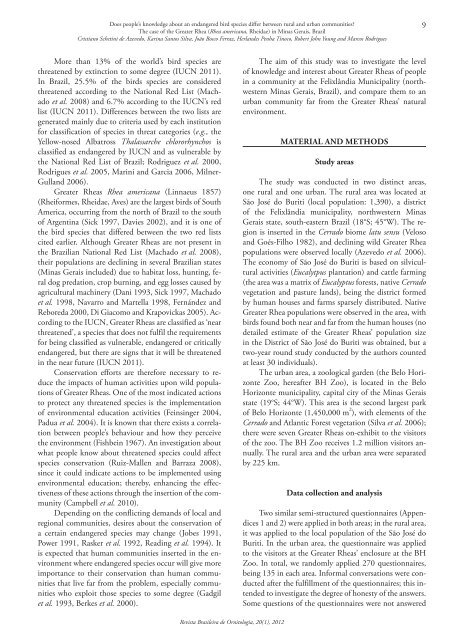Capa 20(1) - fechada.indd - Sociedade Brasileira de Ornitologia
Capa 20(1) - fechada.indd - Sociedade Brasileira de Ornitologia
Capa 20(1) - fechada.indd - Sociedade Brasileira de Ornitologia
Create successful ePaper yourself
Turn your PDF publications into a flip-book with our unique Google optimized e-Paper software.
Does people’s knowledge about an endangered bird species differ between rural and urban communities?The case of the Greater Rhea (Rhea americana, Rheidae) in Minas Gerais, BrazilCristiano Schetini <strong>de</strong> Azevedo, Karina Santos Silva, João Bosco Ferraz, Herlan<strong>de</strong>s Penha Tinoco, Robert John Young and Marcos Rodrigues9More than 13% of the world’s bird species arethreatened by extinction to some <strong>de</strong>gree (IUCN <strong>20</strong>11).In Brazil, 25.5% of the birds species are consi<strong>de</strong>redthreatened according to the National Red List (Machadoet al. <strong>20</strong>08) and 6.7% according to the IUCN’s redlist (IUCN <strong>20</strong>11). Differences between the two lists aregenerated mainly due to criteria used by each institutionfor classification of species in threat categories (e.g., theYellow-nosed Albatross Thalassarche chlororhynchos isclassified as endangered by IUCN and as vulnerable bythe National Red List of Brazil; Rodriguez et al. <strong>20</strong>00,Rodrigues et al. <strong>20</strong>05, Marini and Garcia <strong>20</strong>06, Milner-Gulland <strong>20</strong>06).Greater Rheas Rhea americana (Linnaeus 1857)(Rheiformes, Rheidae, Aves) are the largest birds of SouthAmerica, occurring from the north of Brazil to the southof Argentina (Sick 1997, Davies <strong>20</strong>02), and it is one ofthe bird species that differed between the two red listscited earlier. Although Greater Rheas are not present inthe Brazilian National Red List (Machado et al. <strong>20</strong>08),their populations are <strong>de</strong>clining in several Brazilian states(Minas Gerais inclu<strong>de</strong>d) due to habitat loss, hunting, feraldog predation, crop burning, and egg losses caused byagricultural machinery (Dani 1993, Sick 1997, Machadoet al. 1998, Navarro and Martella 1998, Fernán<strong>de</strong>z andReboreda <strong>20</strong>00, Di Giacomo and Krapovickas <strong>20</strong>05). Accordingto the IUCN, Greater Rheas are classified as ‘nearthreatened’, a species that does not fulfil the requirementsfor being classified as vulnerable, endangered or criticallyendangered, but there are signs that it will be threatenedin the near future (IUCN <strong>20</strong>11).Conservation efforts are therefore necessary to reducethe impacts of human activities upon wild populationsof Greater Rheas. One of the most indicated actionsto protect any threatened species is the implementationof environmental education activities (Feinsinger <strong>20</strong>04,Padua et al. <strong>20</strong>04). It is known that there exists a correlationbetween people’s behaviour and how they perceivethe environment (Fishbein 1967). An investigation aboutwhat people know about threatened species could affectspecies conservation (Ruiz-Mallen and Barraza <strong>20</strong>08),since it could indicate actions to be implemented usingenvironmental education; thereby, enhancing the effectivenessof these actions through the insertion of the community(Campbell et al. <strong>20</strong>10).Depending on the conflicting <strong>de</strong>mands of local andregional communities, <strong>de</strong>sires about the conservation ofa certain endangered species may change (Jobes 1991,Power 1991, Rasker et al. 1992, Reading et al. 1994). Itis expected that human communities inserted in the environmentwhere endangered species occur will give moreimportance to their conservation than human communitiesthat live far from the problem, especially communitieswho exploit those species to some <strong>de</strong>gree (Gadgilet al. 1993, Berkes et al. <strong>20</strong>00).The aim of this study was to investigate the levelof knowledge and interest about Greater Rheas of peoplein a community at the Felixlândia Municipality (northwesternMinas Gerais, Brazil), and compare them to anurban community far from the Greater Rheas’ naturalenvironment.Material and MethodsStudy areasThe study was conducted in two distinct areas,one rural and one urban. The rural area was located atSão José do Buriti (local population: 1,390), a districtof the Felixlândia municipality, northwestern MinasGerais state, south-eastern Brazil (18°S; 45°W). The regionis inserted in the Cerrado biome latu sensu (Velosoand Goés-Filho 1982), and <strong>de</strong>clining wild Greater Rheapopulations were observed locally (Azevedo et al. <strong>20</strong>06).The economy of São José do Buriti is based on silviculturalactivities (Eucalytpus plantation) and cattle farming(the area was a matrix of Eucalyptus forests, native Cerradovegetation and pasture lands), being the district formedby human houses and farms sparsely distributed. NativeGreater Rhea populations were observed in the area, withbirds found both near and far from the human houses (no<strong>de</strong>tailed estimate of the Greater Rheas’ population sizein the District of São José do Buriti was obtained, but atwo-year round study conducted by the authors countedat least 30 individuals).The urban area, a zoological gar<strong>de</strong>n (the Belo HorizonteZoo, hereafter BH Zoo), is located in the BeloHorizonte municipality, capital city of the Minas Geraisstate (19°S; 44°W). This area is the second largest parkof Belo Horizonte (1,450,000 m 2 ), with elements of theCerrado and Atlantic Forest vegetation (Silva et al. <strong>20</strong>06);there were seven Greater Rheas on-exhibit to the visitorsof the zoo. The BH Zoo receives 1.2 million visitors annually.The rural area and the urban area were separatedby 225 km.Data collection and analysisTwo similar semi-structured questionnaires (Appendices1 and 2) were applied in both areas; in the rural area,it was applied to the local population of the São José doBuriti. In the urban area, the questionnaire was appliedto the visitors at the Greater Rheas’ enclosure at the BHZoo. In total, we randomly applied 270 questionnaires,being 135 in each area. Informal conversations were conductedafter the fulfillment of the questionnaires; this inten<strong>de</strong>dto investigate the <strong>de</strong>gree of honesty of the answers.Some questions of the questionnaires were not answeredRevista <strong>Brasileira</strong> <strong>de</strong> <strong>Ornitologia</strong>, <strong>20</strong>(1), <strong>20</strong>12
















